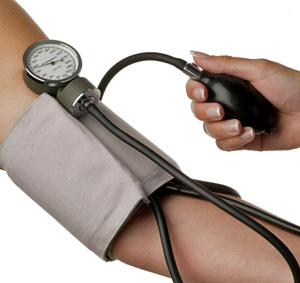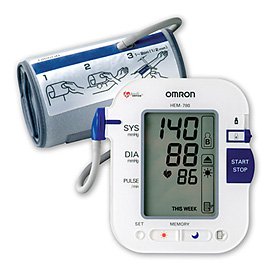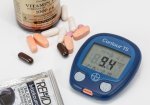Malignant Hypertension
Covering malignant hypertension definition, symptoms, causes, diagnosis and treatment
A complication of hypertension associated with high blood pressure, malignant hypertension is defined as a very serious type of hypertension demonstrated by an unusually sudden increase in blood pressure to very high levels. It runs a rapid course damaging the inner linings of the blood vessels, the heart, kidneys, brain and spleen. The spleen is a large oval organ on the left side of the human body in between the stomach and the diaphragm. It is responsible for immune cell production. Malignant high blood pressure is also known as accelerated hypertension. It's opposite is known as benign hypertension a mild type of hypertension largely asymptomatic for long periods of time.
The clinical definition of accelerated hypertension is rather intellectually taxing. It is defined as high blood pressure linked to bilateral retinal flame-shaped hemorrhages and/or exudates or cotton wood spots, with or without papilloedema.
Malignant hypertension symptoms

Hypertension symptoms generally remain hidden. Before it reaches the stage of being malignant high blood pressure usually symptoms remain hidden until it's getting very late. Of the 75 million people in the United States with high blood pressure a third of them walk about not knowing of their condition because of its largely asymptomatic nature. This state of affairs is not only limited to America. It's everywhere both in the western world and in developing countries.
The following is a list of medically observed symptoms of malignant high blood pressure;
- Headache
- Blurred Vision
- Seizures
- Internal bleeding of the retinas
- Swelling of optic nerves behind the retinas
- Chest pain
- Reduced Urine passage
- Shortness of breadth
- Strange tingling or numbness in the arms, legs and face
Malignant hypertension causes
It must be noted that malignant hypertension is actually a progression of hypertension to become this serious condition or disease that is life threatening. Researchers have found common ground in the fact that socio-economic factors affect the speed with which diagnosis is done. This often also results in under-treatment which seems to be all the right conditions and very important factors in the development of malignant hypertension. Unlike in the western world socio-economic status in poorer populations makes it very difficult to access home based accurate blood pressure monitors which obviously makes it possible to routinely detect high blood pressure and other cardiovascular problems.
In fact as a result of improvements in screening and development of modern diagnosis and treatment procedures, a section of hypertension specialists has come to label malignant high blood pressure a "vanishing disease". Moreover some medical professionals in developed countries claim time and again that they never see the disease. From this perspective it would appear the disease has remained flourishing in less developed societies.
Some researchers have established that patients with accelerated hypertension had a greater chance of coming from impoverished socio-economic groups showing levels of stress exposure which are higher and lacking adequate antihypertensive therapy. It therefore appears as though there is a link between stress and malignant hypertension. This has been reported as a factor in more than a single study.
Factors at play pointing to stress as a cause of malignant hypertension would include insufficient sleep, overwork and mental burden. This further points a finger at the possible role of the sympathetic nervous system in the development of the disease. This particular nervous system is associated with fight-or-flight responses in the human body such as pupil dilation, increased sweating, increased heart rate and increased blood pressure.
In considering what causes hypertension, doctors look at secondary hypertension. Secondary hypertension causes such as heart disease, diabetes, kidney disease and others are approximately 40% of the time linked to malignant high blood pressure. To the surprise of researchers cigarette smoking or tobacco smoking and oral contraceptive pill usage etiological factors long associated with high blood pressure do not confer an increased risk of malignant high blood pressure.
Malignant hypertension diagnosis
In terms of diagnosis blood pressure readings are used in conjunction with other factors to arrive at conclusive diagnosis. Malignant high blood pressure often has a high systolic blood pressure reading of 220mm Hg or higher and a higher diastolic blood pressure reading of 120mm Hg or higher.
The level of blood pressure reading in itself is not enough in diagnosing the disease. Doctors also check for retinal bleeding, accelerated hypertension symptoms and organ damage. Blood vessels in certain places within the body raptures under excessive blood pressure. This often happens with the retina which has tiny blood vessels to with-stand ferocious blood pressure.
Some puzzling diagnosis epidemiological lessons have been learned and reveal the following;
- There is a trend that is opposite to that for essential hypertension, young people are at risk of malignant high blood pressure than older ones.
- Pregnant women with gestational hypertension are at greater risk.
- Individuals with African background in the family line are also at increased risk. This is also a heritage factor consistent with essential hypertension.
- Individuals with a history to do with renal artery stenosis (narrowing of renal artery) are also at increased risk.
The importance of malignant hypertension diagnosis lies in the fact that if untreated or if treatment is excessively delayed a poor prognosis (likely outcome of an illness)rate sets in. Often this will result in a 5 year survival rate of only 1% of diagnosed patients. This means most patients will not make it beyond 1, 2, 3 or 5 year marks. Effective treatment is so important so much that a prognosis rate of 60 to 70% at five years can be achieved. Put in other words this means effective treatment applied on 100 patients will ensure that 60 to 70 of them live to see the fifth year after treatment began.
The following table presents an important classification of blood pressure in adults. This applies to persons 18 years or older not taking antihypertensive drugs and who are not acutely ill.
| CATEGORY | BP systolic/diastolic mm Hg |
| Optimal | <120/<80 |
| Normal | <130/<85 |
| High Normal | 130-139/85-89 |
| Hypertension | |
| Stage 1 | 140-159/90-99 |
| Stage 2 | 160-179/100-109 |
| Stage 3 | >179/>109 |
| Malignant Hypertension | >220/>120 |
Source: Data used includes that from the joint National Committee on Prevention, Detection, Evaluation and Treatment of High Blood Pressure
Malignant hypertension treatment
Hospital admission which might include in the intensive care unit (ICU) for observation and treatment is important and almost always applied. A hypertension diet regimen is also employed on the patient to better control high blood pressure. Intravenous hypertension treatment is in most cases applied. After hospital discharge patients can be prescribed high blood pressure treatment such as Beta-blockers and ACE inhibitors. These are hypertension medications normally administered via reference to specially prepared hypertension guidelines.
Generally survival is significantly improved amongst patients who receive treatment before accelerated hypertension has resulted in extensive vascular damage. It's been observed that patients who present themselves for treatment already showing evidences of serious renal damage generally fail to survive for longer periods. Nevertheless, a significant number maintains active lifestyle for months and years to come once effective treatment has began.
Research has shown that malignant high blood pressure returns in the selfsame patient if the blood pressure is poorly controlled and let to raise again. Investing in blood pressure machines such as the Omron Blood Pressure Monitors or any other reputable monitor brand for home management of blood pressure is essential. Some doctors are of the opinion that there could be some unknown factors behind the disease suggested by its return if blood pressure is left to rebellion.
Theoretically the disease may be prevented by increased awareness and more aggressive treatment of hypertension before it crosses the line. Early treatment of mild to moderate hypertension is key in preventing the development of the disease. It is clear that hypertension under-detection and inadequate management of diagnosed high blood pressure together with poor socio-economic status remain the common denominators.
As a matter of practice and perhaps government policy, malignant high blood pressure cases would substantially decline if only blood pressure measurement across the citizenry would become an integral part of routine medical care.
Malignant Hypertension | Digital Blood pressure Cuff
Return to Hypertension Symptoms from Malignant Hypertension
Return to Hypertension Home Page from Malignant Hypertension
(c) All Rights Reserved. 2010-2015




